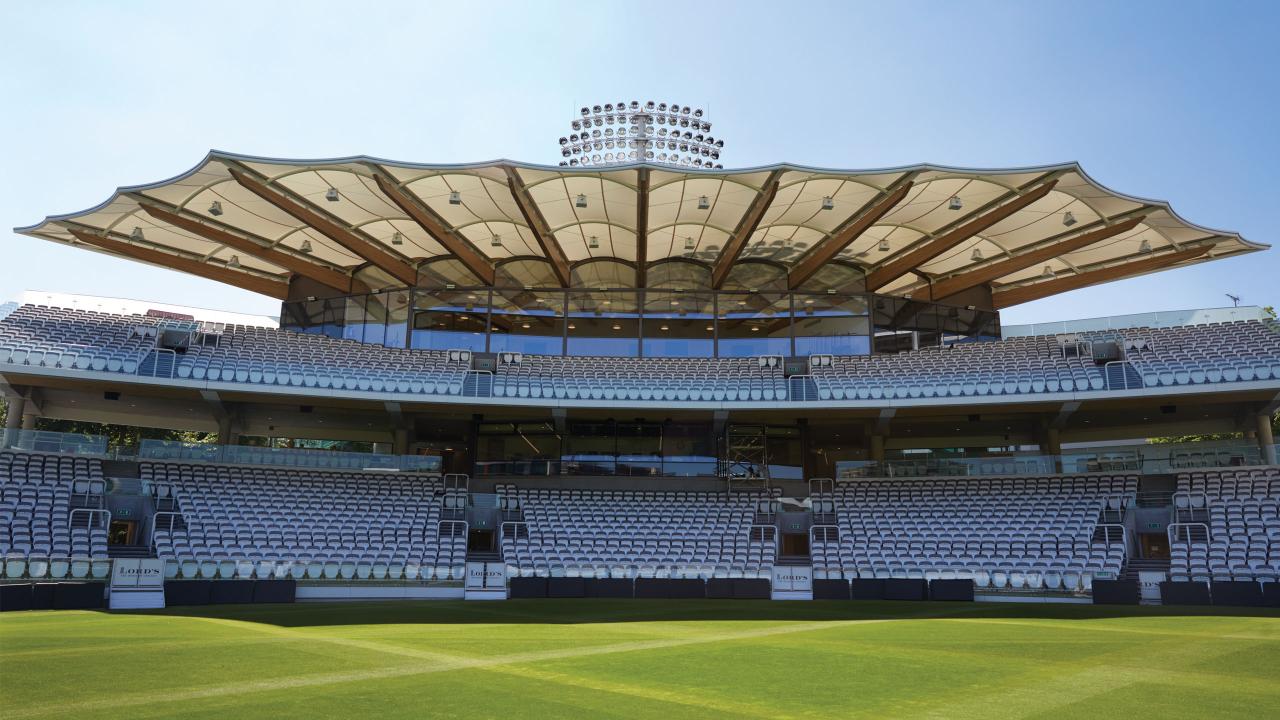
American white oak delivers Lords crowd pleaser
Innovative engineered hardwood beams ensure Lord’s new 2,600-seater stand delivers on looks as well as performance. The cantilevered canopy over the new Warner Stand at Lord’s Cricket Ground describes the long shallow arc of a ball thrown from boundary to wicket.
The translucency of its high-tech PTFE fabric means spectators are never in full shadow, but needn’t shield their eyes against the sun either, and the seating is positioned to provide what some cricket connoisseurs contend are the best sight lines in the ground, diagonally across the field of play. But the new structure is more than an aesthetic success and crowd pleaser. It’s also a technical ground-breaker in terms of the material used for the 11 cantilever beams, up to 23m long, carrying the canopy. These are glue-laminated American white oak and it’s the first time the species has been employed in this format on this scale and in such a performance critical environment – forming the primary structure of a roof projecting out over 2,674 spectators.
Such a prestige showcase for its design and technical performance is also expected to spur white oak glulam’s wider use in construction – perhaps even more ambitiously.
The structure is the outcome of close partnership between stadium specialist architect Populous, engineers Arup, American white oak supplier Robinson Lumber, German engineered wood manufacturer Hess Timber, BAM Construction and the American Hardwood Export Council (AHEC), which is committed to developing structural application of U.S. hardwoods. AHEC provided technical advice and helped source the timber.
The brief to Populous from the client, the Marylebone Cricket Club (MCC), was to deliver a stand that overcame the shortcomings of its predecessor. It also had to stamp its own visual identity, while sitting sympathetically alongside Lord’s other buildings.
“Lord’s comprises individual stand styles rather than one stadium design; it’s an architectural campus, described as ‘pavilions around a village green’,” said Populous Senior Principal and Project Lead Philip Johnson. “So we made design nods to the other stands, notably the tent-like fabric roof of the Mound Stand. At the same time, we aimed to bring something new; a building that created an impression of lightness – hence the canopy comprising fabric rather than glass, and the 13m cantilevered section that makes it seem to float over the crowd. We wanted to capture cricket’s summer character and the ambience of a local club marquee.” Populous also wanted that ambience in the restaurant at the rear of the stand.
“The beams extend back and we use the same roof fabric, but double-skinned with a mid-layer of Aerogel insulation,” said Johnson. “So we have the same translucency, but, combined with double glazing and renewables, including ground source heating, it enables the building to be used for hospitality year-round. Then on summer match days the wide windows can be thrown open, creating one space that really engages spectators with the game.”
The new restaurant also occupies a significantly larger space than the old, as do safety, security and match control rooms in the building. And, as it addresses the popular Lord’s garden, the architects paid as much attention to the rear façade design, incorporating green walls.
Of course, another key design focus were the stand’s sight lines, said Mr. Johnson. Besides having no vertical supports to get in the way, the seats are also raked at the same angle as neighbouring stands’ to ensure unrestricted views.
Meanwhile, the choice of timber for the beams, he added, ‘made itself’. “It helps stamp the stand’s unique identity among its neighbours and wood and fabric seemed a natural marriage,” said Johnson. “We also wanted the stand to be and be seen to be as sustainable as possible, and what could be more sustainable than timber from well-managed forests?”
Timber and particularly hardwood, also seemed appropriate to cricket, with its willow bats and ash bails. In fact, both species were considered for inclusion, but ultimately lost out to American white oak for floors and joinery, with architect and client favouring a coordinated materials pallet.
American white oak came on the scene through discussions with Arup. It already had experience of working with engineered U.S. hardwood in recent years, having partnered with AHEC on its London Design Festival structural timber showcase projects; the laminated U.S. red oak Timber Wave, tulipwood cross laminated timber (CLT) Endless Stair and 2016’s The Smile, which used the first industrial scale tulipwood CLT panels.
“The criteria for white oak’s selection were engineering-driven and architectural,” said Arup’s Giancarlo Torpiano. “European oak was considered, but American white oak has a reputation for better grading and a clean, furniture-grade finish. It’s relatively dense too so has very good strength and stiffness properties enabling us to reduce the size of the beams, which was important architecturally. Since they run from an external, uncontrolled environment, with relatively high fluctuations in temperature to an internal, controlled one, the thermal properties of this timber were also a major advantage.”
The question mark over U.S. white oak was that it was untried in its demanding and highly technical role at Lord’s, notably with little research done into the strength of hardwood finger joints. That meant testing times for beam makers Hess Timber.
“We had extensive experience of using temperate and tropical hardwood for glulam and finger jointed components, including structural elements,” said Hess head of sales Markus Golinski. “It’s mainly been beech, but additionally oak, iroko, meranti, teak and western red cedar. We also produce hybrid glulam, combining spruce lamellas with a hardwood exterior surface, including white oak for a project at King’s College, Cambridge.”
“But we’ve previously only produced white oak glulam for small, relatively non-technical projects, so we were starting from scratch; from finger jointing, to laminating the lamellas.”
While the density and stiffness of the timber may have helped Arup achieve the minimal beam deflection required, it also posed challenges, said Golinski.
“The problem was our usual glues wouldn’t absorb sufficiently due to the wood’s density. In fact, we initially had some delamination. But we ultimately found a modern melamine adhesive that worked. So, success was down to latest glue developments – ten years ago these beams wouldn’t have been possible.”
Hess submitted prototype beams for evaluation at the MPA Materials Testing Institute at the University of Stuttgart, a European notified body for construction materials certification, noted for its work with engineered timber. The ‘godfathers of glulam’, as Golinski described them.
Producer, test centre and Arup debated over whether to test to destruction, but decided it was essential as the glulam played such a critical role and had no European Product Approval (EPA). However, it passed the trials and Hess proceeded to produce the full-scale beams, with the inclusion of a slight pre-camber.
“Another advantage of American white oak’s stiffness and uniformity was that we could predict deflection levels and camber very precisely,” said Golinski.
Weighing up to four tons apiece and 350mm x 900mm at their deepest point, the beams travelled the 600 miles from Hess’s Kleinheubach plant to north London two-per truck and were hoisted into place by contractor BAM, with crane mats laid over the hallowed Lord’s turf.
The beams connect to the concrete wall at the restaurant rear via embedded steel plates, and cantilever beyond steel columns framing the windows, where they’re fixed with glued-in rods. Above, the canopy is stretched over steel hoops, giving the roof its scalloped effect, and these fix to slender t-section rails with even slimmer fins below sitting on rails bolted to the timber.
The system was co-engineered by Arup and Hess, with the steel to fabric connections from Leicht Engineering.
“The system avoids issues of differential movement between materials due to thermal expansion and contraction, with the timber alone providing the primary structure and the steel simply sitting on it,” said Torpiano. “This also prevents steel and fabric picking up residual effects from timber creep.”
The American white oak is inherently durable, but as added protection Remmers finish was applied to shield it from driven rain and ultraviolet light penetrating the canopy. However, no fire retardant was necessary.
“Fire is sometimes a client concern when building with wood, but glulam is difficult to ignite and chars slowly,” said Torpiano. “In fact, in fires it’s been shown to maintain structural integrity longer than steel.”
Now complete, all involved believe the building could inspire more structural use of hardwood glulam, and U.S. white oak glulam in particular.
“Now we have the experience and test results, we won’t be starting from zero for the next white oak project and we’ve also invested in equipment to machine it,” said Golinski. “Hardwood production worldwide is also forecast to rise due to climate change and increased planting, so we need to find uses for it.”
Populous also sees potential.
“I’m excited to explore the possibilities further,” said Johnson. “There’s a limit on size of project suited to glulam, due to the depth of beams required. But the Warner Stand may not be it.”
Underlining his enthusiasm for the project, Johnson planned to attend the first game played before the completed structure in May.
“I won’t be sitting in the stand as it’s MCC members only,” he said. “But I’ll enjoy watching spectators enjoying the stand. After all, giving them a great match-day experience was our ultimate objective.”
The secret’s in the sourcing
Robinson Lumber was assiduous in sourcing and selecting the U.S. white oak for the Warner Stand’s white oak glulam beams. The New Orleans-based company, one of the biggest suppliers of American hardwood to Europe, worked closely with AHEC, and glulam manufacturer Hess Timber, evaluating both northern and southern U.S. white oak stock.
“We undertook microscopic cellular and density analysis and ultimately decided with Hess on northern due to the tight grain and growth ring orientation,” said Hank Marchal, managing director of Robinson Lumber Europe.
“We also ensure uniformity by sourcing from mills within 100km radius of our Indiana concentration yard.” Initially Hess and Robinson looked at prime quality FAS timber, but settled on ‘one common’.
“When we’d ripped the timber to 5” width after kilning and they’d cut, planed, finger jointed and glued the lamellas for the beams, more economic one common did the job just as well,” said Marchal. “In fact it was so dense and strong that in destruction testing, the glue-lines fractured before the timber, which was not expected.”
He was equally impressed with the finished product and believes it will open doors to wider uses of engineered American hardwood. “Putting together these project driven initiatives, like the Warner Stand, with the raw material can only serve to highlight the potential of what is really an under-utilised natural resource,” he said.
David Venables, European director of the American Hardwood Export Council (AHEC), agreed. “It’s been a long, sometimes difficult journey to get U.S. hardwood to this point, starting with AHEC’s involvement in sourcing white oak for the much smaller glulam beams in Westminster’s Portcullis House in 2000. Since then we’ve organised various showcase projects demonstrating different species’ engineered product and structural potential. Now we have this fabulous large-scale commercial application of white oak glulam made by one of the leading engineered timber producers. It should really open architects’ eyes to the fact they have this alternative option for their structural materials portfolio at a time when they’re looking to build more with wood worldwide.”
